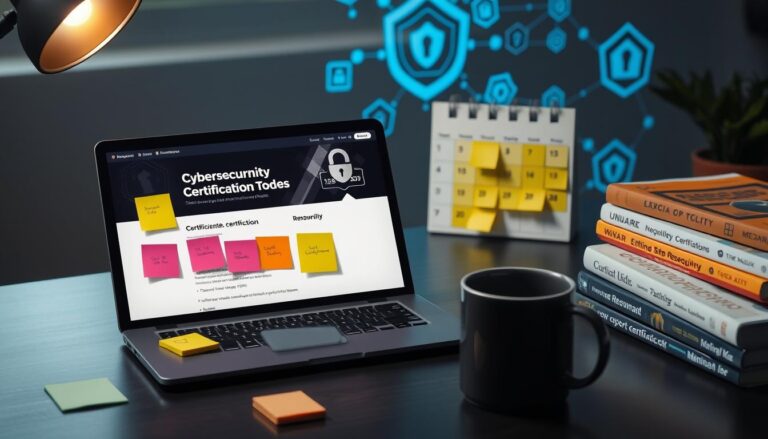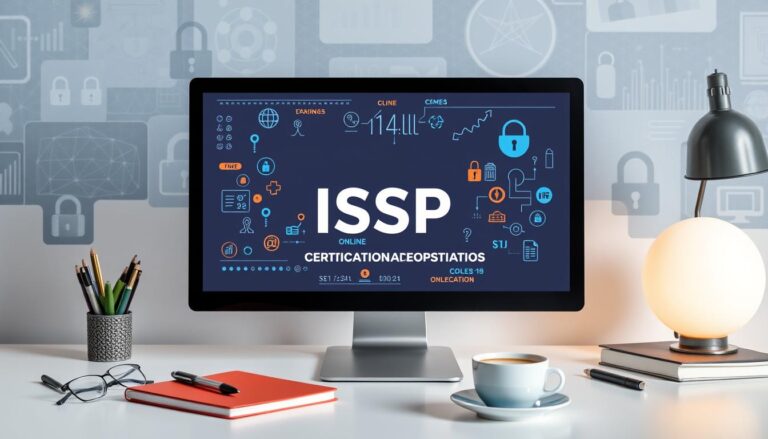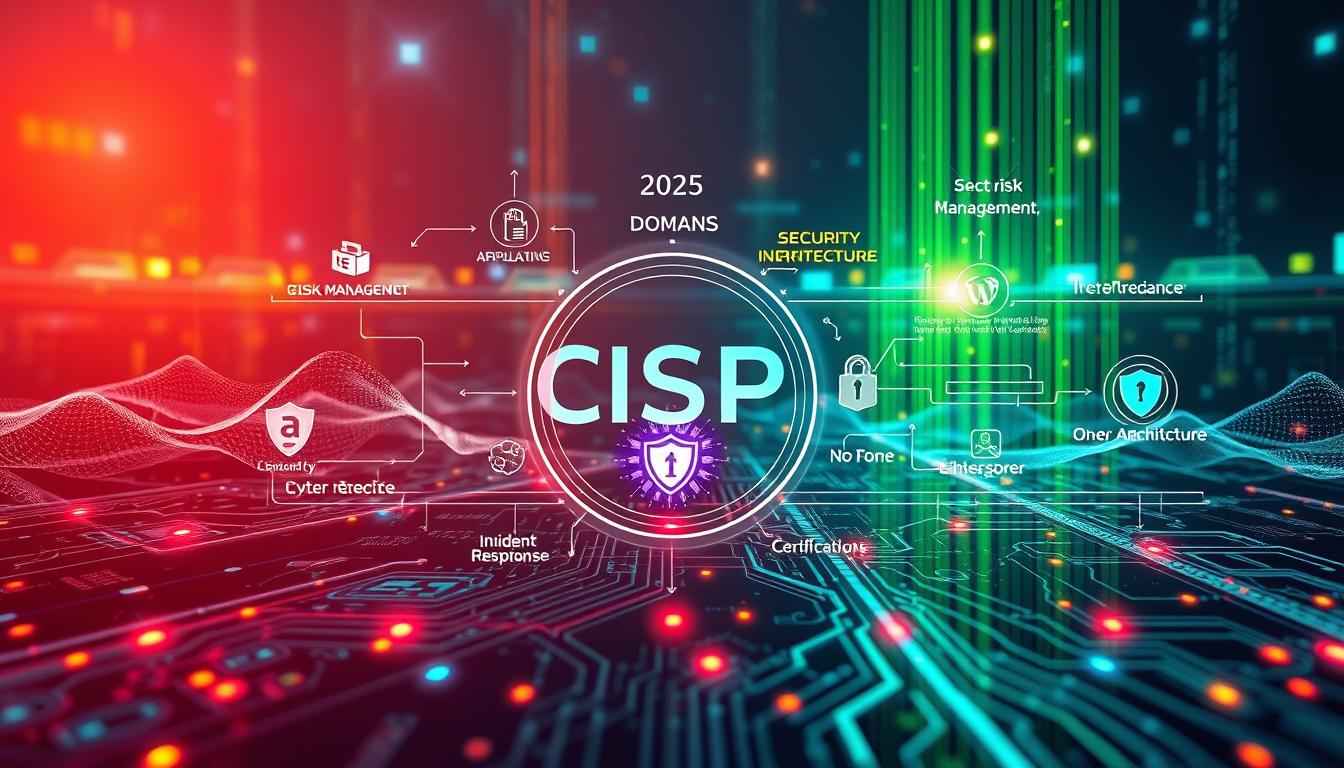
Did you know the Certified Information Systems Security Professional (CISSP) exam has eight domains? Each one is key to cybersecurity. By 2025, these domains will see updates and changes in their importance. This shows how the field is always evolving.
With 16% of the exam focused on Security and Risk Management, it’s vital to understand these domains. This knowledge is essential for those in the cybersecurity field. It helps you stay ahead in a rapidly changing world.
Knowing about the CISSP domains in 2025 is critical, with changes starting on April 15, 2024. Whether you’re experienced or new to information security, keeping up with these updates is important. It boosts your preparation and credibility in the field. Read on to learn more about the updated CISSP domains and their impact on your career.
Introduction to CISSP Certification
The CISSP certification is a top choice in the field of information security. It’s given by ISC2 and shows that IT pros have the right skills. To get it, you must pass a tough exam that tests your knowledge in eight key areas.
To qualify, you need at least five years of full-time work in two of these areas. These areas include managing risks, protecting assets, and more. This way, you learn both the technical and managerial sides of security.
Getting a CISSP is great for roles like Chief Information Security Officer or Security Analyst. There are many ways to study for it, like online or in a classroom. These methods help you not just pass the exam but also apply your skills in real situations.
The Importance of CISSP in Cybersecurity
The CISSP certification is key in today’s cybersecurity world. Threats are getting smarter, and companies see CISSP as vital. It shows you know a lot about security and can lead security efforts well.
Companies are under a lot of pressure to keep their data safe. Last year, over 80% of them faced serious security issues. Also, 33% had cloud data breaches. This shows how important it is to have skilled cybersecurity experts.
Getting CISSP certified can boost your career. You might earn more and find better jobs. Many top jobs need this certification. It proves you’re knowledgeable and ready for the future of work.
Keeping your CISSP up to date is also key. You need to earn CPE credits every three years. This keeps your skills sharp and shows you’re serious about protecting companies. Getting CISSP certification can make your career better and prove you’re a cybersecurity expert.
Overview of the CISSP Domains
The CISSP certification has a comprehensive CISSP domains breakdown. It ensures candidates have the needed knowledge for cybersecurity management. This certification is highly sought after in U.S. job markets. It requires a deep understanding of the overview of CISSP domains.
This preparation is key for passing the exam and boosting organizational security.
There are eight domains in the CISSP domain structure, each critical for an organization’s security. The domains are as follows:
- Security and Risk Management: 16%
- Asset Security: 10%
- Security Architecture and Engineering: 13%
- Communication and Network Security: 13%
- Identity and Access Management (IAM): 13%
- Security Assessment and Testing: 12%
- Security Operations: 13%
- Software Development Security: 10%
Each domain focuses on specific areas and has different weights in the CISSP exam. The exam’s content was updated in April 2024. This update aligns with today’s cybersecurity challenges and best practices. Knowing these domains helps you tackle modern cybersecurity issues.
Updated CISSP Domains for 2025
The world of cybersecurity is always changing. This means we need to update CISSP domains to tackle new challenges and technologies. By 2025, we’ll focus more on mobile security, cloud solutions, and advanced threat assessment. These areas will help security experts deal with today’s complex cybersecurity issues.
New Focus Areas in Cybersecurity
It’s key to know the updated CISSP domains for any cybersecurity pro. For 2025, we’ll focus on:
- Mobile Security: Fixing issues with mobile devices.
- Cloud Solutions: Keeping data safe in the cloud.
- Advanced Threat Assessment: Finding and stopping new threats.
The Impact of Emerging Technologies
New technologies like AI and machine learning are big in the CISSP world now. Security pros need to understand these techs and how they affect security. Knowing them well helps you use them to improve security plans.
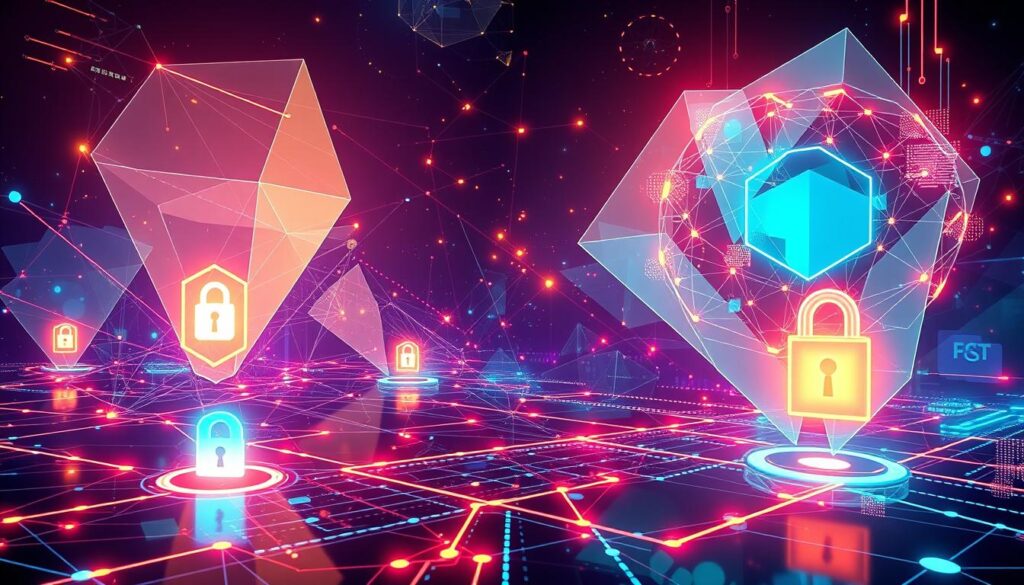
Here’s a detailed look at the updated CISSP domains for 2025. It shows how important each area is for the exam:
| CISSP Domains | Weight |
|---|---|
| Security and Risk Management | 15% |
| Asset Security | 10% |
| Security Architecture and Engineering | 13% |
| Communication and Network Security | 14% |
| Identity and Access Management (IAM) | 13% |
| Security Assessment and Testing | 12% |
| Security Operations | 13% |
| Software Development Security | 10% |
Detailed Breakdown of Each CISSP Domain
Understanding the CISSP domains is key to knowing the different areas of information security. Each domain has important knowledge needed to be good at information security. Here, we give a detailed look at the eight CISSP domains, showing their importance in the exam and main focus areas.
Security and Risk Management
This domain is all about security governance, risk management, and following rules. It’s 16% of the CISSP exam and shows how important it is to have good policies and strategies for security.
Asset Security
This domain is about how to handle and protect information. It’s 10% of the exam and covers making sure data is safe from start to finish.
Security Architecture and Engineering
This domain is about the design that keeps systems safe. It’s 13% of the exam and talks about putting security into the design of systems.
Communications and Network Security
This domain is about keeping data safe when it’s being sent. It’s also 13% of the exam and includes knowing how to keep networks and data safe.
Identity and Access Management (IAM)
IAM is about controlling who can access what. It’s 13% of the exam and focuses on making sure only the right people can get to information.
Security Assessment and Testing
This domain is about checking if security measures are working. It’s 12% of the exam and covers how to test and make sure security is up to par.
Security Operations
This domain is about the day-to-day work of keeping systems safe. It’s 13% of the exam and includes things like watching networks and fixing problems.
Software Development Security
This domain is about making sure software is safe from start to finish. It’s 10% of the exam and is all about keeping software secure.
| CISSP Domain | Weight (%) | Description |
|---|---|---|
| Security and Risk Management | 16 | Focuses on governance, risk management, and compliance. |
| Asset Security | 10 | Covers the classification and handling of information. |
| Security Architecture and Engineering | 13 | Involves design principles essential for system security. |
| Communications and Network Security | 13 | Ensures secure transmission practices. |
| Identity and Access Management (IAM) | 13 | Focuses on user access controls and identity management. |
| Security Assessment and Testing | 12 | Evaluates security measures in place. |
| Security Operations | 13 | Covers operational aspects and incident response. |
| Software Development Security | 10 | Encompasses security practices during the software lifecycle. |
Compliance and Regulatory Considerations in CISSP
Compliance in CISSP is key to good security practices in companies. Knowing the cybersecurity laws is a must for those aiming for CISSP. Laws like GDPR and HIPAA are important for following the law and making security better.
Knowing CISSP compliance standards helps you deal with complex rules. It also makes you a better professional. The CISSP exam tests your skills in handling these rules. Domain 1: Security and Risk Management makes up 16% of the exam, showing how important legal knowledge is.
Companies use frameworks like ISO, NIST, and COBIT to link security with business plans. These frameworks help make sure security and compliance work together. They also help in managing risks well.
The CISSP domains now focus more on compliance. It’s important to keep up with new tech like AI and blockchain. Knowing privacy laws is also key, showing the need to understand both privacy and broader rules.
Here’s a table that shows the main compliance areas for CISSP:
| Compliance Area | Relevant CISSP Domain | Description |
|---|---|---|
| GDPR | Security and Risk Management | Regulation focused on data protection and privacy for individuals within the EU. |
| HIPAA | Asset Security | Regulation ensuring the confidentiality, integrity, and security of healthcare information. |
| NIST Standards | Security Architecture and Engineering | Framework providing guidance for managing cybersecurity risk. |
| PCI DSS | Communications and Network Security | Standard aimed at securing credit and debit card transaction systems. |
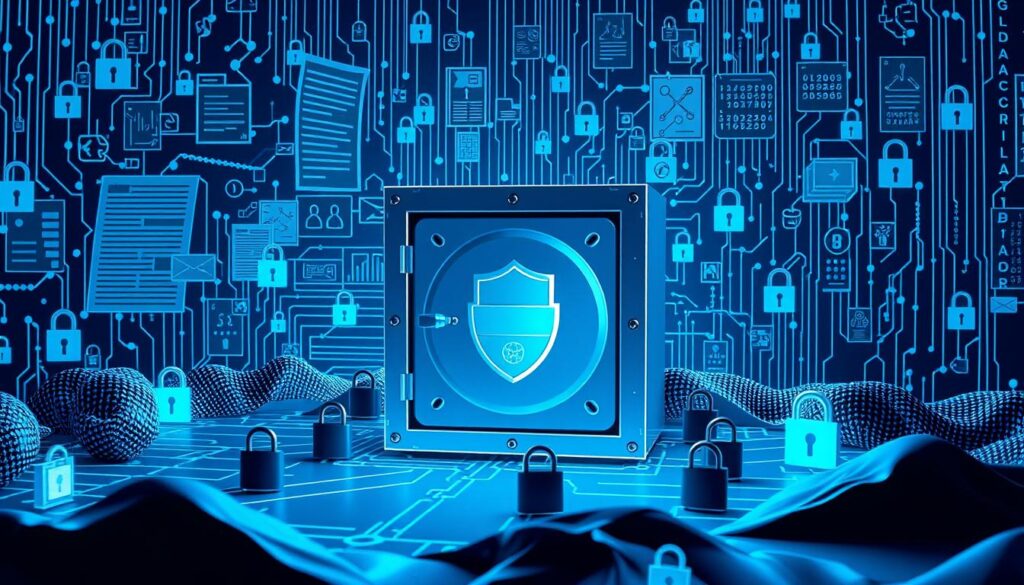
Preparing for the CISSP Exam in 2025
Getting ready for the CISSP exam needs a solid plan. First, learn the updated CISSP domains well. Knowing the exam format is key; it has 125 to 150 questions to answer in 3 hours. You need to score at least 700 out of 1,000 to pass.
Make a study plan that fits your life, aiming for 9 months of study. Spend 1-2 hours each day studying. Mix up your study methods. Training programs, like a 5-day course, can really help.
Use CISSP exam resources to boost your prep. Apps like Pocket Prep and LearnZapp have lots of practice questions. Watching review videos and listening to audiobooks can also help.
Practice in a setting like the real exam to get used to the time and feel. Joining a study group for CISSP can also help. Stay focused on understanding, not just memorizing, and keep up with new cybersecurity trends.
Resources for CISSP Study and Preparation
To prepare for the CISSP exam in 2025, you need a variety of resources. The official ISC2 study guides are a must. They give a deep dive into the Common Body of Knowledge (CBK). This guide is 674 pages long, covering all key topics.
Using different CISSP prep tools can really help. Look into online courses or training boot camps for structured learning. Joining community forums and study groups is also great. You can share ideas and get help from others aiming for the same goal.
The best CISSP prep resources go beyond books. Here are some tools to consider:
- Destination CISSP Flashcard App: It has over 1,100 flashcards to help you remember key terms and definitions.
- Destination CISSP Questions App: It has more than 100 practice questions that are similar to the real exam, boosting your confidence.
- All in One CISSP Exam Guide: It has 1400+ practice exam questions that you can try out with a user-friendly testing engine.
- Eleventh Hour CISSP book: It condenses all the important exam content into a quick-to-review format, covering all eight domains.
- ISC2 CISSP Official Practice Tests: It has hundreds of real questions that cover each domain of the CISSP CBK, giving you a feel for the actual exam.
Plan to spend 100 to 200 hours studying, depending on your background. Getting your CISSP could take a few months to a year. To make your study time more effective, use resources like the NIST Security And Privacy Controls Special Publication, 800-53 Revision 5. It offers insights into key security and privacy controls for the CISSP domains.
Conclusion
Exploring CISSP domains shows how important it is to stay current in cybersecurity. The updated CISSP certification is more than passing a test. It’s about mastering key principles to protect digital spaces today.
By embracing these updates, you improve your knowledge and meet employer standards. This is vital for your career.
In this summary of CISSP certification, remember that preparation is key. Studying well and knowing the eight domains of the Common Body of Knowledge (CBK) boosts your success chances. Soon, the Computerized Adaptive Testing (CAT) will make your test experience more personalized.
Preparing for CISSP in 2025 should be a strategic plan. Set goals and consider joining mastermind groups or teaching others. This approach not only prepares you for the exam but also enhances your career in cybersecurity.
Source Links
- CISSP Common Body of Knowledge (CBK): The 8 Domains Explained
- Changes to the CISSP Exam Weighting – What You Need to Know
- CISSP Exam Refresh FAQ
- CISSP – Certified Information Systems Security Professional | ISC2
- Explore Programs – Continuing Education at Penn State
- Navigating the Future of CISSP Certification: Trends and Developments in Cybersecurity
- Is CISSP Certification Still Worth It in 2025? Find Out Why You Should Consider It!
- 8 tips for CISSP exam success in 2025
- Top 8 CISSP Domains Explained To Crack CISSP Exam in 2025
- CISSP Cheat Sheet 2025 | Pass the Exam in 1st Attempt – Vinsys
- 8 CISSP Domains Explained to Ace Exam in 2025
- CISSP Exam Outline
- The 8 CISSP Domains Explained [2025 Updated] With Exam Tips
- CISSP Syllabus And CISSP Exam Outline In 2025 (Exam Preparation With Tips)
- CISSP domains overview (2024) | Essential information
- Top 8 CISSP Domains? Cheat-sheet with Tips & Tricks
- CISSP Experience Requirements
- CISSP 2024 Domains: Navigating the Latest Updates
- Before Your Exam
- January 2025 News: NEW Certification Renewal Program, CISSP Learning Path, and more!
- How I Conquered the CISSP Exam: 9 Months, Top Resources, and Proven Strategies
- Best CISSP Study Guides for 2025 + CISSP Study Plan
- Best CISSP Study Resources: Top CISSP Books & Preparation Materials
- How to Pass the CISSP Exam in First Attempt (2025)
- CISSP Exam Changes That You Should Be Aware of in 2025
